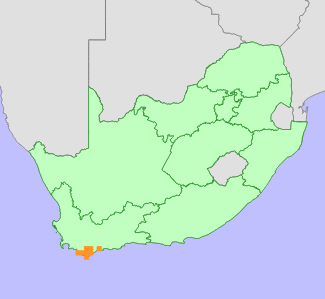|
Scientific Name | Disphyma dunsdonii L.Bolus |
Higher Classification | Dicotyledons |
Family | AIZOACEAE |
National Status |
Status and Criteria | Vulnerable A2c; B1ab(i,ii,iii,iv,v) |
Assessment Date | 2008/04/28 |
Assessor(s) | N.A. Helme & D. Raimondo |
Justification | At population reduction of east 30% is estimated based on habitat loss to crop cultivation over the past 30 years (generation length ± 10 years). EOO 2200 km², less than 10 remaining locations continue to decline due to ongoing habitat loss to urban expansion around Bredasdorp, alien plant invasion and crop cultivation. |
Distribution |
Endemism | South African endemic |
Provincial distribution | Western Cape |
Range | Bredasdorp and Elim to Potberg. |
Habitat and Ecology |
Major system | Terrestrial |
Major habitats | Overberg Dune Strandveld, Eastern Ruens Shale Renosterveld, Central Ruens Shale Renosterveld, Potberg Ferricrete Fynbos, Elim Ferricrete Fynbos, Agulhas Sand Fynbos |
Description | Ferricrete depressions filled with water in winter and spring, dry in summer. |
Threats |
| Most severely threatened in the past by habitat loss to wheat, protea and vineyard cultivation and decline is ongoing. In addition, remaining subpopulations are threatened by competition from alien invasive plants and urban expansion around Bredasdorp. |
Population |
Population trend | Decreasing |
Assessment History |
Taxon assessed |
Status and Criteria |
Citation/Red List version | | Disphyma dunsdonii L.Bolus | VU A2c; B1ab(i,ii,iii,iv,v) | Raimondo et al. (2009) | |
Bibliography |
Goldblatt, P. and Manning, J.C. 2000. Cape Plants: A conspectus of the Cape Flora of South Africa. Strelitzia 9. National Botanical Institute, Cape Town.
Raimondo, D., von Staden, L., Foden, W., Victor, J.E., Helme, N.A., Turner, R.C., Kamundi, D.A. and Manyama, P.A. 2009. Red List of South African Plants. Strelitzia 25. South African National Biodiversity Institute, Pretoria.
|
Citation |
| Helme, N.A. & Raimondo, D. 2008. Disphyma dunsdonii L.Bolus. National Assessment: Red List of South African Plants version . Accessed on 2025/08/31 |
 Comment on this assessment
Comment on this assessment


